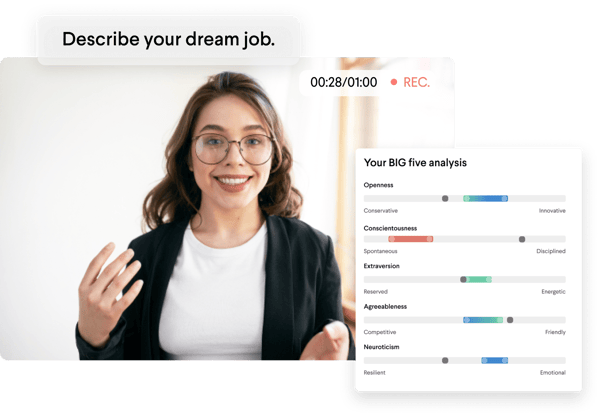Part of building an effective sales team is understanding your starting point. What's the best way to begin?
Through measuring. One common methodology used throughout every department and every industry is a skills gap analysis.
This can be used to identify very specific areas for improvement and feedback cycles. It not only gives direction towards actionable steps for an employee or manager to improve their work, but it's also a useful feedback tool that can be used to better team processes and a company's products and services.
For sales teams, pairing this kind of framework with AI-powered feedback, can mean shortening training time and increasing the delivery pipeline.
To break down each step of the skills gap analysis, begin by figuring out the goals of the organization's performance. This may seem like a macro point of view, particularly when it comes to a particular sales role. However, this creates a baseline to learn how an individual person or individual role means to enhance the performance of the organization.
The skills gap analysis is particularly useful when there's no obvious "problem", but a company feels they need to make changes but are unsure of exactly where.
Aligning an organization's larger strategic goals is key when developing the skills gap analysis.
This analysis may show where your company can grow; and where it's failing to grow due to lack of team members, technical support, or inefficient processes. From these learnings, you'll learn how to maximize.
In a recent McKinsey Global Survey, 87% of executives said they were experiencing skills gaps in the workforce.
But less than half of the respondents had a clear sense of how to address the problem. And this isn't even touching on the economic uncertainty and the increasing competition for key roles, like high-performing sales team members.
To fill this growing skills gap, future-oriented companies are leveraging the efficiency of AI to train customer-facing roles in the area of soft skills.
More than 90% of companies with world-leading brand recognition and high levels of customer satisfaction use artificial intelligence (AI) solutions to increase how they come across to their customers. From Alibaba, and Uber, to Lexus, these firms are using AI to "supplement and extend" the skills of their customer-facing team members.
It's more than bots.
These and more iconic firms are using AI in their operational processes to engage with customers across every phase of their journey, including fostering a more intuitive and communicative exchange. It's become a fundamental part of their growth strategy.
If the most celebrated and successful brands are using AI to better equip customer-facing team members, a skills gap analysis is the starting point to kick off integration.
Skills Gap Analysis
A good skills gap analysis aims to assess the current sales teams's capabilities and the skills and knowledge they need to become high-performers within your company and industry.
With these learnings, a sales team manager possesses the data to make decisions regarding training, upskilling, and succession planning. This creates a "future-proof" method in creating a competitive advantage in longevity.
The skills gap analysis can be divided into 4 steps:
Step 1: Measure skills
Step 2: Define scope
Step 3: Select project team members
Step 4: Act on your data
1. Measure skills
First things first: measuring the skills sales team members already have under their belt. It's important to record the skill level of your current employees alongside the skills that are in-demand to be successful at the role. Look to industry benchmarks or past work experiences in assessing what is needed now. Rate the skill level, either on a numerical scale, one to 10.
One being the employee does not have much knowledge of the needed skills and 10 meaning this employee is already proficient. An alternative method to measure may be used a more general ranking method: low, moderate, and high (and variations of it, "low-moderate", "moderate-high", etc.) to show how well a sales team member measures up.
The next step is to determine the skills your current workforce possesses. This can be accomplished through tools such as:
Performance reviews
360s
Skills assessments
Behavioral assessments (like Retorio)

2. Define the scope
Sales team managers may already know what the outcome of the skills gap analysis. It may be that certain roles can do cold-calling potential customers, manage the sales funnel, or launch a new project and facilitate its deliverables. In defining the scope,, deliverables, features, functions, tasks, deadlines, people involved, and the cost.
Sales lies in the cross-hairs of many departments, from marketing to customer success. Speak with managers or colleagues from those teams. They may need to be involved in the successful outcome of a role. In planning out projects, they may need to be involved.
Defining the scope also includes its limitations and/or constraints. The COVID-19 pandemic, for example, may limit whether sales people may meet customers in person. They may not be able to go to industry events, or may need additional equipment or tools for remote selling.
You'll want to define what skills, technical tools, or equipment that is needed for a position. By creating a comprehensive overview what is needed when you're conducting a candidate experience or any other function of talent management, you'll better understand any underlying gaps.

3. Select project team members
According to the Project Management Institute’s 2016 Pulse of the Profession report, $122 million of every $1 billion invested in projects is wasted due to poor execution. Managing projects are part of every work life, in every sector, in every department. Projects occur within your human resources or talent management practices, marketing, sales, and elsewhere. The key is selecting the right team members to assist you in the skills gap analysis.
The sub-process of selecting team members is a process in itself. It’s important to remember that team members are the interface between the function of the job and the project’s goals. When choosing your team, focus on professional experience first. If they’ve worked on a relevant project or they clearly have the skills to understand the requirements of a project, this is crucial to a successful project.
Other considerations are availability, their interests, and their personal characteristics, or personality. Team building for important projects is crucial for positive outcomes. Our clients, like Airtame, didn’t want to leave their team building to chance. They selected Retorio to give them deep insights into how teams can fit together based on their personality’s values and traits.
4. Act on your data
Your team has measured the necessary skills for fill the skills gap in your organization. There are two primary ways of filling gaps: you either train your in-house employees or your hire from outside your organization. You may want to consider which is best, depending on your demand and budget.
It's common that more than 50% of companies choose to train their employees to take on vacant positions. They train them through workshops, paying for certification programs, or other means. By training your employees, you're offering value to their professional development. Depending on how you go about, this could increase employee retention and loyalty.
You may want to organize a skills gap analysis based on the training. If employees need to work on their soft skills, it could be important work to understand how they could personally improve in the specific areas of soft skills. Many organizations don't have the resources for personalized training in this metric; fortunately Retorio gives feedback to employees---and gives them feedback within minutes. This kind of speed matters for growing organizations.
If the skills gap can't be filled with training, you may need to hire from outside. Or you may simply need fresh insight via new employees. Even as hiring and recruitment practices evolve in this new era, it's important that the hiring process remain simple. With social distancing and flexible working, it's incredibly important that hiring managers have these recruitment processes digitized.
How to Pair AI in training to fill the skill gap

60% of iconic companies said they had the right mix of human and automated customer communication channels, compared to only 26% of poor-performing companies.
Pairing AI to equip sales teams is on the rise.
Today’s companies are facing a growing soft skills gap.
59% of surveyed hiring managers and 89% of executives reported difficulty recruiting candidates with the requisite soft skills, such as communication, teamwork, and leadership.
Increase active listening and responding
The best salespeople truly listen to a need and have the capability to respond with how their product and/or service tailor-fits their needs. This is the most basic soft skill, but one that may take time honing. This creates stronger connections and communication channels with not only a customer but also within the internal team.
Reduce bias via video simulations
With Retorio, sales teams gain access to a library that simulate real-world situations as a sales person. It will support team members in adjusting unconscious bias and allow them the opportunity to reflect and respond as they build up their diversity knowledge skill set.
Build loyalty through development
Sales team members often want to develop their own skills so they can improve their performance. Most sales persons work on commission and therefore know their ability to earn is contigent on the ability to sell. With Retorio, they don't have to necessarily only practice on real-life customers; simulations can give ample time to reflect and receive immediate feedback on their performance.
In speaking with Harvard Business Review, Kshitij Nerurkar, North America Head of Cognizant’s Learning Academy highlights that for customer-facing roles “practicing client presentations (and) then receive instant feedback to fine-tune their communication and data-storytelling skills" is a key advantage of technologies like AI and VR. It's incredibly
low cost compared to human training sessions and allows for tailored and immediate feedback. 





